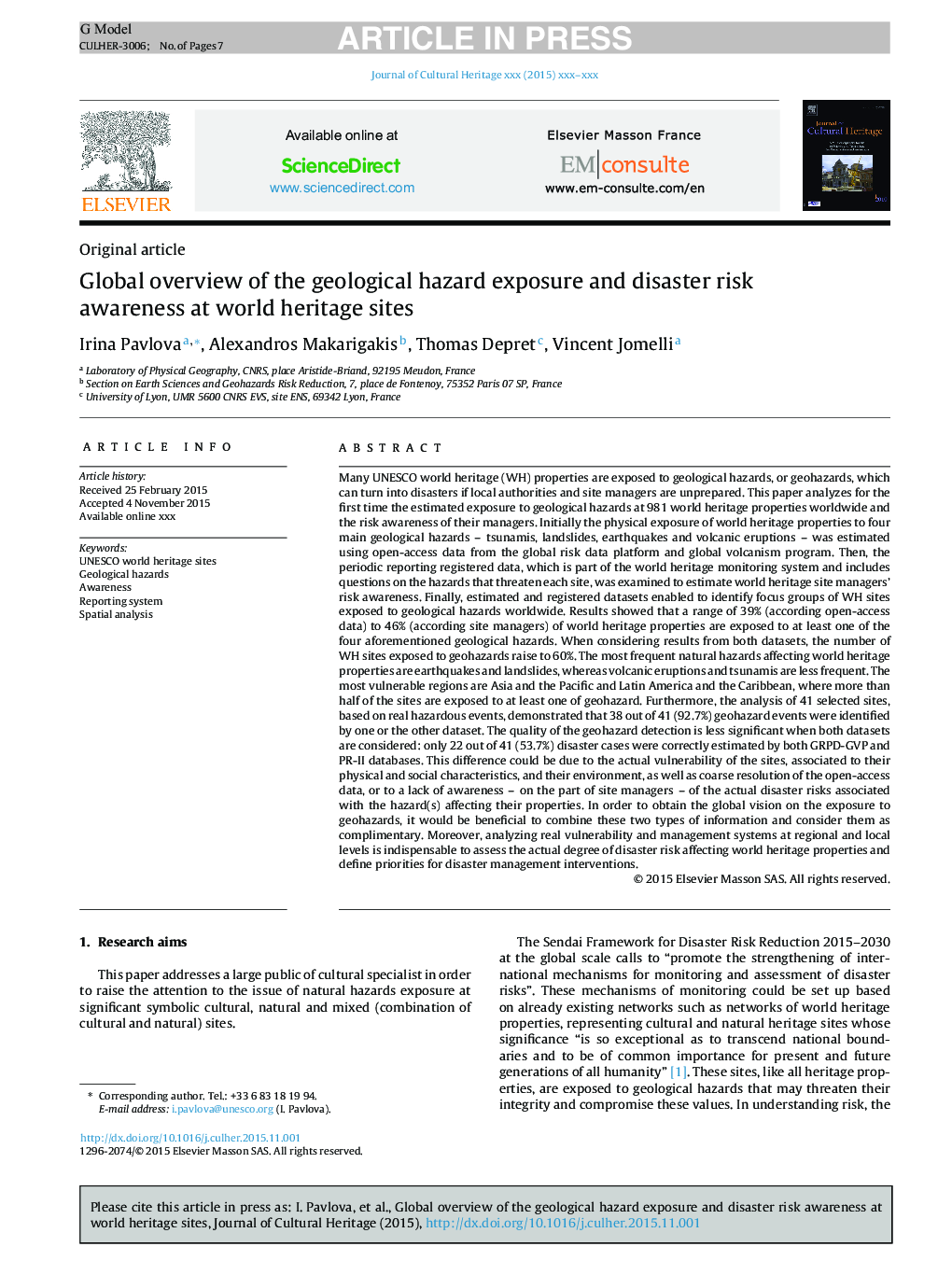| کد مقاله | کد نشریه | سال انتشار | مقاله انگلیسی | نسخه تمام متن |
|---|---|---|---|---|
| 7446408 | 1483948 | 2017 | 7 صفحه PDF | دانلود رایگان |
عنوان انگلیسی مقاله ISI
Global overview of the geological hazard exposure and disaster risk awareness at world heritage sites
ترجمه فارسی عنوان
مروری جهانی درباره آلودگی زمین شناختی و آگاهی از خطر بروز بحران در سایت های میراث جهانی
دانلود مقاله + سفارش ترجمه
دانلود مقاله ISI انگلیسی
رایگان برای ایرانیان
کلمات کلیدی
سایت های میراث جهانی یونسکو، خطرات زیستشناختی، اطلاع، سیستم گزارش دهی، تجزیه و تحلیل فضایی،
موضوعات مرتبط
مهندسی و علوم پایه
شیمی
شیمی تئوریک و عملی
چکیده انگلیسی
Many UNESCO world heritage (WH) properties are exposed to geological hazards, or geohazards, which can turn into disasters if local authorities and site managers are unprepared. This paper analyzes for the first time the estimated exposure to geological hazards at 981 world heritage properties worldwide and the risk awareness of their managers. Initially the physical exposure of world heritage properties to four main geological hazards - tsunamis, landslides, earthquakes and volcanic eruptions - was estimated using open-access data from the global risk data platform and global volcanism program. Then, the periodic reporting registered data, which is part of the world heritage monitoring system and includes questions on the hazards that threaten each site, was examined to estimate world heritage site managers' risk awareness. Finally, estimated and registered datasets enabled to identify focus groups of WH sites exposed to geological hazards worldwide. Results showed that a range of 39% (according open-access data) to 46% (according site managers) of world heritage properties are exposed to at least one of the four aforementioned geological hazards. When considering results from both datasets, the number of WH sites exposed to geohazards raise to 60%. The most frequent natural hazards affecting world heritage properties are earthquakes and landslides, whereas volcanic eruptions and tsunamis are less frequent. The most vulnerable regions are Asia and the Pacific and Latin America and the Caribbean, where more than half of the sites are exposed to at least one of geohazard. Furthermore, the analysis of 41 selected sites, based on real hazardous events, demonstrated that 38 out of 41 (92.7%) geohazard events were identified by one or the other dataset. The quality of the geohazard detection is less significant when both datasets are considered: only 22 out of 41 (53.7%) disaster cases were correctly estimated by both GRPD-GVP and PR-II databases. This difference could be due to the actual vulnerability of the sites, associated to their physical and social characteristics, and their environment, as well as coarse resolution of the open-access data, or to a lack of awareness - on the part of site managers - of the actual disaster risks associated with the hazard(s) affecting their properties. In order to obtain the global vision on the exposure to geohazards, it would be beneficial to combine these two types of information and consider them as complimentary. Moreover, analyzing real vulnerability and management systems at regional and local levels is indispensable to assess the actual degree of disaster risk affecting world heritage properties and define priorities for disaster management interventions.
ناشر
Database: Elsevier - ScienceDirect (ساینس دایرکت)
Journal: Journal of Cultural Heritage - Volume 28, NovemberâDecember 2017, Pages 151-157
Journal: Journal of Cultural Heritage - Volume 28, NovemberâDecember 2017, Pages 151-157
نویسندگان
Irina Pavlova, Alexandros Makarigakis, Thomas Depret, Vincent Jomelli,
